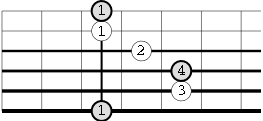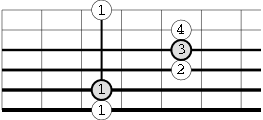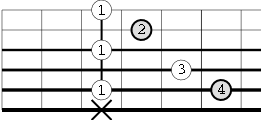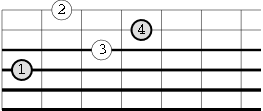


Previous Index Next
Guitar Bar Chords
Fundamental Chord Forms
There are several fundamental bar chord forms. A bar chord is a chord
that is "position independent": the same chord pattern can be played at
any location on the fretboard. The position at which a pattern is
played determines which note the chord corresponds to - for example,
the 1st form placed at the 3rd fret gives a G chord, and placed at the
5th fret gives an A chord. The fundamental patterns are called "bar
chords" because most involve "barring" across all the frets with the
first finger; in fact, it's this "barring" that makes the chord
position-independent.
In the following diagram, the strings appear "upside down", with the
heaviest string on the bottom. That's because this is the way the
guitarist sees them when he looks at the fretboard when holding the
guitar.
There are three fundamental bar chord forms.
First Form
Major

<-- Peghead
Body -->
Minor

In the first form, the "root" note is present on the first, fourth and
sixth strings. The position of the bar thus determines the chord: if
it's on the 3rd fret, the chord is a G, since the note at the 3rd fret
on the first (or sixth) string is a G. Similarly, if the bar's on the
5th fret, the chord is an A, and so on.
Note that to obtain the minor chord from the major chord, just one note
is changed: the second finger, on the third string, is lifted. We'll
look at this in more detail later when we consider variations on the
fundamental chord forms.
Second Form
Major

Minor

In this form, the "root" note is on the fifth and third strings. Again,
the position of the "bar" determines the chord, but now it's the note
on the fifth string; for example, if the bar's on the 3rd fret, the
note on the fifth string is a C, so this is a C chord.
Again note that to get the minor chord from the major, only one note is
changed: the note on the second string is moved down one fret. However,
the fingers need to be rearranged to accomodate this.
Third Form
Major

Minor

In this form, only the major chord is a true bar chord, and note that
the sixth string isn't barred or included in the chord. In addition,
the minor chord uses just four strings, and is "skewed" downward
somewhat from the position of the major chord.
For the major chord, the "root" note occurs on the fifth and second
strings; for the minor chord, it's on the fourth and second strings.
Comments/questions: jsevy@cs.drexel.edu








